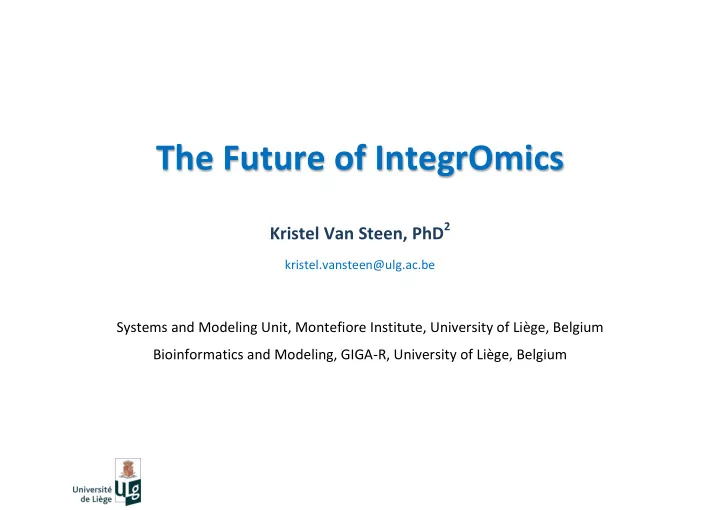

K Van Steen Chapter 8 – The Future of IntegrOmics The Future of IntegrOmics Kristel Van Steen, PhD 2 kristel.vansteen@ulg.ac.be Systems and Modeling Unit, Montefiore Institute, University of Liège, Belgium Bioinformatics and Modeling, GIGA-R, University of Liège, Belgium
K Van Steen Chapter 8 – The Future of IntegrOmics OUTLINE Do we have a motive and opportunity for data integration? What are the key components of data integration Do we also have the means?
K Van Steen Chapter 8 – The Future of IntegrOmics Backbone references Hamid et al 2009. “ Data integration in genetics and genomics: methods and challenges ” (review article – appeared in Human Genomics and Proteomics ) Davies et al 2009. “ Integrative genomics and functional explanation ” (presentation)
K Van Steen Chapter 8 – The Future of IntegrOmics Motive and opportunity for data integration
K Van Steen Chapter 8 – The Future of IntegrOmics Availability of different data resources Increased storage capacities and joint efforts to establish data banks with easy data access make available huge amounts of clinical, environmental, demographic data Rapid technological advances lead to various types of -omics data: - Genome (G) - Epigenome (E) - Transcriptome (T) - Proteome (P) - Metabolome (M) - Phenome (F) - Lipidome, glycome, interactome, spliceome, etc...
K Van Steen Chapter 8 – The Future of IntegrOmics Omics: what’s in a name? Omics data provide comprehensive descriptions of nearly all components and interactions within the cell. Three data categories: - Components - Interactions - Functional-states (Joyce and Palsson 2006)
K Van Steen Chapter 8 – The Future of IntegrOmics Genomics: defined here as the study of the whole genome sequence and the information contained therein Transcriptomics : provides information about both the presence and the relative abundance of RNA transcripts, thereby indicating the active components within the cell Proteomics: aims to identify and quantify the cellular levels of each protein that is encoded by the genome … (Joyce and Palsson 2006)
K Van Steen Chapter 8 – The Future of IntegrOmics Data hierarchy (adapted from: Davies et al 2009, Integrative genomics and functional explanation)
K Van Steen Chapter 8 – The Future of IntegrOmics
K Van Steen Chapter 8 – The Future of IntegrOmics One by one? (adapted from: Davies et al 2009, Integrative genomics and functional explanation)
K Van Steen Chapter 8 – The Future of IntegrOmics Functional genomics Full functional understanding of the etiology of a complex phenotype involves: - identifying the genetic, molecular, and environmental attributes that influence the phenotype, and - elucidating the biological pathway that fully defines the influence and describes how it occurs. The epigenome as the interface between the genome and the transcriptome, controlling long-term gene expression and integrating environmental signals, needs to be “integrated” into the functional genomics analysis.
K Van Steen Chapter 8 – The Future of IntegrOmics A “forgotten” – ome data resource: the exposome The clinical management of cancer and other complex diseases can be substantially improved by “integrative” approaches. . ( See also Wild 2005, Complementing the genome with an “exposome”…)
K Van Steen Chapter 8 – The Future of IntegrOmics Motivation to integrate different data resources In general, distinct data types provide a different, only partly independent and complementary view on most complex disease related questions to date. The “genome” on its own “has turned out to be a relatively poor source of explanation for the differences between cells or between people” (Bains 2001 ). So we have the motive, and the opportunity …
K Van Steen Chapter 8 – The Future of IntegrOmics (Boston Globe) … but do we also have the means for “integration” ?
K Van Steen Chapter 8 – The Future of IntegrOmics (Mission Impossible @ google) … but do we also have the means for “integration” ?
K Van Steen Chapter 8 – The Future of IntegrOmics
K Van Steen Chapter 8 – The Future of IntegrOmics « Integration » « Integration »
K Van Steen Chapter 8 – The Future of IntegrOmics Integration as “obtaining a m ulti-dimensional perspective ” ? of chromosome 17 of the HCC2218 breast cancer cell line Copy number, LOH, and DNA methylation, and profiling identifies an amplification of ERBB2 coinciding with allelic imbalance and loss of methylation. The expression of HCC2218 is significantly higher than a panel of normal luminal and myoepithelial cell lines. (Breast Cancer Res. 2006;8(5):R56.)
K Van Steen Chapter 8 – The Future of IntegrOmics Key components of data integration
K Van Steen Chapter 8 – The Future of IntegrOmics Data integration: what’s in a name? Definition Narrow: “Process of statistically combini ng data from different sources to provide a unified view of the whole genome and make large-scale statistical inference” (Lu et al 2005). Broad: “Combining evidences from different data resources, as well as data fusion with biological domain knowledge, using a variety of statistical, bioinformatics and computational tools” (Van Steen)
K Van Steen Chapter 8 – The Future of IntegrOmics Key components of (statistical) data integration Step 1 • Formulating the biological (statistical) problem Step 2 • Identifying the (characteristics of the) data types Step 3 • Data preprocessing Step 4 • Data integration Step 5 • Interpretation
Recommend
More recommend